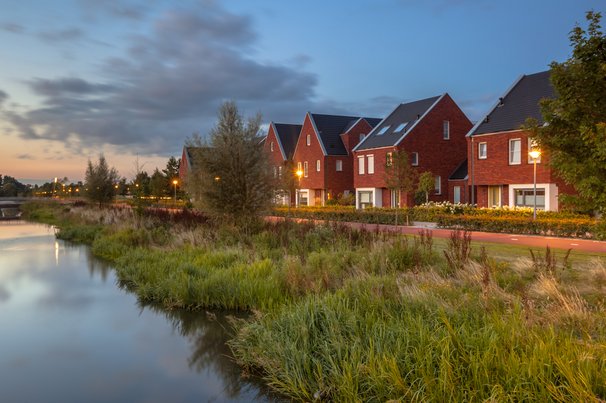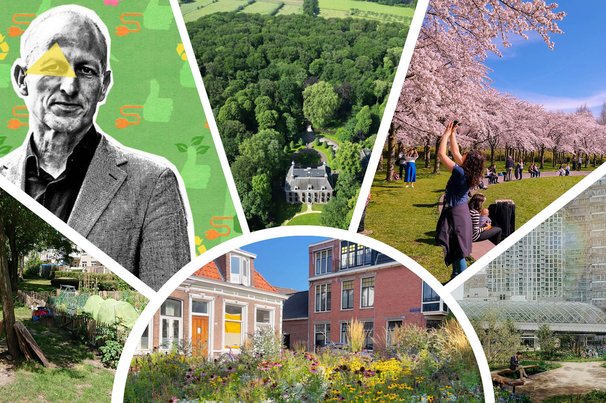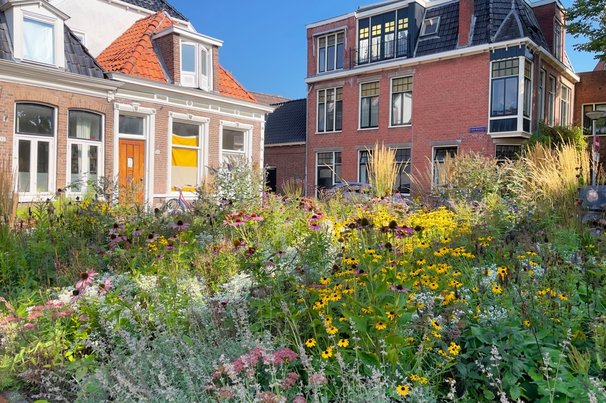Nieuws ABSTRACT - Despite that real estate has historically been viewed as a local phenomenon, real estate industries have been gradually but inevitably influenced by globalisation and transnational economies. This not only includes the rapid development of the real estate sector in emerging economies facilitated by global investment, but also some dramatic changes in traditional real estate market like western Europe and North America following the economic crunch since 2007. As more real estate agencies globally attempt to seek opportunities beyond national borders, it becomes increasingly important to recognise the reasoning behind the internationalisation process of real estate sector, the consequences towards the real estate sector, and the implication for current urban development in cities around the world.
The development of Chinese real estate sector in the era of globalisation
Introduction
Real estate has historically been viewed as a local phenomenon due to its predominant local tradability. The best of “location” has always been the most important focus for local builders and investors. Nevertheless, in today’s globalized world, the integration of global financial sector as well as the internationalisation of services sectors and manufacturing sector accelerates the internationalisation of various sub-sectors of the real estate industry. Builders, brokerage firms, consulting and service firms, real estate financial firms and investors from traditional real estate market, like the U.S.A and western Europe, are not only limited to their traditional real estate market, but increasingly attempt to expand their horizons to a world-wide base. In this paper, I will look at the reasons behind this phenomenon and what implications followed in real estate industry. I will also examine the development process of Chinese real estate sector under the influence of globalisation and internationalisation of real estate sector, as well as its recent visa verse process under the go-global strategy in recent years. Finally, I will discuss what implications internationalisation of real estate sector may bring to cities.
Globalization and the real estate industry: reasoning and implication
Real estate industry has increasingly become globalised. A number of reasons that may have played a role in facilitating the internationalisation process of real estate sector, as is listed below:
1. Technological advancement: the prevalent use of ICT and communication technology extended the geographic reach and weakened the nexus between “local” and “location”. It is still location, location, location but perhaps not local, local, local as it used to be.
2. Upsurge in global economy and financial integration: the development of a variety of different financial instruments allows global investors to add foreign real estate physical asset to their portfolio and hopes to achieve higher return, portfolio diversification and the ability to hedge inflation.
3. Liberalization and opening up of real estate market in emerging economies: The increasing opening-up of formerly closed economies in the developing world offers significant opportunities for real estate firms across the globe. Liberalization of business licensing, taxation and property ownership regulation in some of the largest real estate market facilitates the participation of western real estate in global opportunities.
4. The consumers are also becoming increasingly global. For example, the move of manufacture sector to developing countries led to the relocation of manufacturing factories, R&D centres, logistic centres and creates demand for offices and personal accommodation. Besides, global events and specific relations established between cities lead to short-term and long-term increase in international projects (Bardhan and Kroll 2007)
The internationalisation of real estate sector may imply some dramatic changes related to real estate market, real estate services and real estate finance. For the real estate market, this international process brings opportunities as well as certain risks to local real estate market. Since substantial demand may arise from beyond the local and national borders, local real estate market becomes more complex and more difficult to predict. It is especially true in the global cities such as London and New York, where foreign real estate players play an important role in local real estate market and many of the properties were purchased by international buyers.
For the real estate finance, the highly integrate global financial market offers great opportunities for global investors to diversify real estate portfolio in both traditional real estate market such as the united States and Western Europe and in emerging economies such as China, India, Brazil and South Africa. Some of the financial instruments like REIT become increasing popular outside of the American market. Besides, global investment offers diverse resources for local real estate market to develop. Nevertheless, highly integrated global financial market also has its downside. In economic crisis, global capital flow out in a panic and leave local financial institutions and real estate market collapse. This happened during the 1997 Asian financial crisis, when global investors run out of Southeast Asia, Japan and South Korea with their investment, leaving slumping currencies, devalued stock markets and other asset prices. In other cases, reduced barriers to entry new real estate market enables speculative capital flows – the so-called hot money – to move quickly in and out of markets to capture a short-term profit on interest difference. Most of the hot money went to portfolio investment market the globalisation process may also play a role in creating real estate bubbles.
Regarding real estate service, the internationalisation of real estate market accelerate local real estate market to adopt global real estate standards, developing correspondent legal and professional infrastructure needed to attract companies, businesses and investment capital. Reiss (2002) suggests that global investors, owners and consumers are driving forces in the process “by generally taking a consistent approach and using the same methodologies, valuation techniques, tax analysis, limited liability structures, metrics, and models to invest in or acquire properties or do business from market to market”. The move towards more standardised real estate service creates opportunities for real estate agencies from traditional real estate market to enter emerging markets with their advanced knowledge in the sector.
One important new territory for global real estate investors to explore is the real estate market in emerging economies. Countries like China, India and Brazil are among the biggest and fast-growing emerging market with long-term potential. In the last several decades, China, India and Brazil have all experienced strong GDP growth, strong urbanisation trend and strong growth of household incomes. The massive rise of the middle-class population, with an estimate of 800 million in a decade, creates demand for a variety of economic goods, including real estate. These untapped markets are young and growing, representing a significant opportunity. Given the fact that the destinations of traditional international capital flow – U.S. and Western European market grow more slowly, there is a growing interest in developing market in Asia, and more recently, Latin America. Morgan Stanley, for example, has invested in 17 markets ranging from the United States, Western Europe to Japan, China and Brazil since the 1990s. The Asia market has accounted for 25% of the real estate holdings from Morgan Stanley.
Compared with developed economies, the real estate market of the emerging economies can be characterised as “embryonic and growth oriented” (Lynn et al 2011) However, entry into these markets can be difficult due to a weaker legal structure and sometimes ambiguous laws governing real estate rights, title, and investment. Despite the increasing demand for housing, office, retail and industrial properties and a rapidly growth of relatively unsophisticated real estate players, these markets are large, diverse, complex, highly fragmented, immature (Lynn et al 2011). For most of the emerging markets, liberalisation and privatisation helped opening up the real estate market that was closed to the outsiders. Lynn et al (2011) stated that there are still limited major foreign players in the office space, retail (shopping centres/malls), hospitality (hotels/serviced apartments), IT/business parks, and industrial/logistics/warehousing sectors, and limited foreign presence in for-sale residential. It is therefore interesting to examine how global environment influence the development of local real estate market in such local context. In this article, we use China as an example to examine how local real estate market is established and developed under the influence of global forces. In comparison with other emerging economies, China’s real estate sector emerged from non-existing four decades ago and has now become one of the biggest in the world, owning a great deal to the globalisation process and the experienced borrowed from other mature real estate market.
Establishment of real estate sector in China and its Internationalisation process
Before China’s economic reform in 1978, China was under the so-called socialist central planning system. The state decided what and how much the dominant state-owned work units (Danweis in Chinese) acquire urban land for production expansion and residential use. Because land was not considered as a commodity, the allocation of land was then free of charge for an indefinite period and the constitutions banned land transaction. In the same token, housing was mainly provided Danweis as welfare. Real estate market during this period was non-existing.
The open-door policy was designed as part of a survival strategy to ‘ensure China’s entry into the capitalist global economy and into the informational age, using lessons learned from the Asian “tigers”’ (Xia 2000). China’s reformists recognised the importance of reintroducing the markets in land and real estate. The main aim of land reform was to move from administrative allocation of state-owned land to free transfer for an unlimited period and finally to a new market system in which land-use rights would be transferred for an agreed period against payment. China adopted a land-use right tenure system similar to the leasehold tenure system in Western countries, which separates land from buildings or improvements. The central aim of housing reform was to use the emerging real estate market to commoditise and commercialise housing. Housing reform was another key factor in encouraging the growth of China’s real estate market. Shanghai was one of the few Chinese cities to conduct a series of pilot housing reforms to attempt to reduce its housing problems. In fact, the re-establishment of a real estate market in China largely initiated with the breakthrough of housing reform (Chen 2007: 163). Reforms introduced since 1980 involved the introduction of new housing construction systems, the establishment of housing corporations, the sale of houses to overseas Chinese, the sale of houses to local residents at subsidised prices, rent reform, the establishment of a housing provident fund and the privatisation of public housing.
The establishment of land market and housing market reflects a tendency of adopting global real estate standards, developing correspondent legal and professional infrastructure. Like most of the reform-era Chinese laws that "borrow extensively from Western legal doctrines, concepts, procedures, and terminology" (Guthrie 1999:127), the new land policy was based on the experiences of other countries and areas that have the leasehold tenure system and have years of successful experience in maximising land transfer for value, especially from those of Hong Kong and Singapore (Chan 1999: 54). In both cases, the government own most of the land in their territories, if not all, and thus exert almost monopolistic control directly over land supply, planning and development control. Both governments use land as a revenue generator. In the case of Hong Kong, land lease through public bidding in Hong Kong maximises the land value and contributes to a large extent to Hong Kong’s economic development and the government’s revenue. These advantages have been taken into account in the various laws and regulations China established on land ownership and the land tenureship system (Chen 2007).
The gradual evolving of the housing market also demonstrate the emerging housing market, which share many similarities with the popular Singapore model characterised by Housing Provident Fund, though each step of reform was taken with extreme caution. In Shanghai, the first housing market was established in 1979. Luxury houses were sold on a commercial basis to overseas Chinese and their relatives and later to Shanghainese with sufficient purchasing power. Other houses were also made available to Shanghainese on a commercial basis, though preference was given to those with a serious housing problem. These two sections formed the entire internal housing market, a market which was only open to Chinese clients, though there was also an external housing market providing houses for foreign buyers. The difference between the two markets was that land used by the external market was transferred against payment of a fee for land-use rights, whereas land used by the internal housing market was either allocated free of charge or for a fee below the commercial rate. The two housing markets were finally integrated in 2001, when the same land transfer fee was charged to both Chinese and foreign investors, regardless of origin, so encouraging the development of a more healthy and mature real estate market.
Land and housing reform could only provide the conditions necessary for and favourable to the emergence of a real estate market. The growth of the real estate market and the real estate sector generally depended on a multitude of factors affecting supply and demand. One influential element of globalisation is the inflow of global capital. Sassen (2001, p. 37) addressed the importance of FDI in the process of capital relocation since ‘much of the geographic dispersion of production and of the reorganisation in the financial industry is international rather than domestic’. She also saw a trend of FDI flows in manufacturing from highly developed countries to Latin America and later to Southeast Asia and to China. Attracted by continuing rapid economic growth, a vast supply of cheap labour, rising incomes and the increasingly consumerist culture of the Asian-Pacific region, business has sought to take advantage of that vast untapped market and we have seen a continuous increase in the amount of FDI injected into the region, as well as the arrival of multinational corporations and global pension funds. Olds (2001, p. 24) suggested a similar transition in capital inflow to the property market in the same area: ‘it is clear that in an overall sense, global capital has been flowing into Asia-Pacific property markets, linking together cities and engendering relationships of uneven interdependencies across space’.
Over the years China has become one of the biggest recipients of FDI. FDI flows were primarily directed towards special economic zones (SEZs) such as Pudong New Area, in Shanghai, and the open coastal cities (e.g. Shanghai). In 2005 China even surpassed the United States as the country receiving the highest inflow of FDI (see Figure 1). This unprecedented success was the result of a series of factors, including the size of the potential market, low labour costs, good infrastructure, preferential policies (e.g. tax credits), increasing political openness, geographical factors, political stability and even the country’s exchange rate regime. Although FDI focused mainly on the manufacturing sector, a substantial amount of FDI inflows were poured into urban development projects to benefit from China’s construction boom. For Chinese urban managers, after a long period of suffering from a shortage of capital to upgrade the local urban environment, this capital is essential for stimulating the local urban (re)development process.
 Figure 1: Net FDI in China (1982-2015). Enlarge. (Source: Chinaglobaltrade.com)
Figure 1: Net FDI in China (1982-2015). Enlarge. (Source: Chinaglobaltrade.com)
Whether global capital flow into in Chinese real estate sector as funds or directly participate in local real estate market as real estate developers, global investors have a tendency to involve global architects, engineering companies, financial firms, account bureaus and other internationally renowned, high-quality real estate service sector from traditional real estate markets. Although their main service was initially mainly for multinationals, the cutting-edge innovation and high quality these firms presented have gradually be noticed and welcomed by local players. In some case, these international players even help to set-up new standard in construction industry and real estate service. The development of Jinmao Tower in Shanghai is a good example to show how the involvement of global firms gradually but surely redefined local standard on high-rise design, construction and project management (Chen and Wigmans 2006). For local government, involving a small amount of such players can serve to transform local real estate sector in the quickest way. For local players, the global players are both competitor and potential collaborative partners. In both cases adopting related international standard to increase and maintain own competitive become increasingly urgent for local players.
Despite the professional advantage, global real estate players may still suffer from the lack of knowledge in local tradition, culture and politics and therefore face substantial difficult when operating in local real estate market. The master thesis of Chen (2013) critically examined the entry strategies of a number of Dutch architecture firms to expand in Chinese market. She suggested that Dutch firms not only should recognise the complexity of Chinese real estate market, but pay attention to look for experienced Chinese representatives that understand both cultures, have extensive working experience in both local environment and can be trusted with their personal integrity. In other real estate service sector, circumstance may change but similar concern sustains.
China’s joining of World Trade Organisation, China’s rapid economic growth to become the second largest economy in the world, and China’s economic integration with the global economic facilitated the development of China’s real estate sector, but also made local real estate market in China more vulnerable towards global economic fluctuation. The Asian Financial Crisis between 1997 and 2000 and the on-going Credit Crunch both affected the development Chinese cities and property market heavily. In recent years hot money become a new phenomenon that has substantial impact on local real estate sector. Between 2002 and 2008, net inflow of hot money in China amounted to 577 billion US dollars. Meanwhile, China also experienced two period with net hot money outflow: The first period started in October 2008, when the global financial crisis intensified due to the fall of Lehman Brothers. The hot money flows out of China amounted to about 232 billion US dollars from October 2008 to February 2009. The second period with outflows started in September 2011 and intensified in May 2012. The annual outflow of hot money was about 403 billion US dollars in 2012. The financial fluctuation also causes instability in real estate sector, igniting hot debate regarding the existence of real estate bubble in China. The uncertain real estate market also led bankruptcy of a number of real estate companies. In major cities such as Beijing and Shanghai, it is not difficult to observe in diverse locations giant half-constructed real estate projects in the inner cities untouched due to lack of capital.
Go-global strategy: China’s outbound real estate investment
Since the financial meltdown of Wall Street in 2008, the whole world has experienced stagnant and decline in economic growth, as well as slump in demand and productivity in the markets for all kinds of goods and services. In different places around the world, real estate segment also saw stagnancy in price. However, in some cities like London, there is actually a rise in price whereas the price in rest of the U.K. remains stagnant. The decisive driven force behind the rise in price is the investment poured in from the entire world. Not only nervous Europeans eagerly purchase property in London, but also investors from North America as well as emerging economies such as Russia and China pour capitals in London. International buyers have helped pushed up the average price of a home in the exclusive borough of Kensington and Chelsea to more than £1 million for the first time and push the price increase by a 3.6 per cent in April 2013, contrast with the decline of 0.3 per cent in England as a whole in the same month. In fact, the above example just shows how economic recession triggered global investors to look for potential real estate to invest worldwide. Russian billionaires are buying up luxury condos in New York City, Brazilians are buying up condos in Miami, and Americans are eying Buenos Aires.
Compared with other global players, the globalised Chinese companies started with modest initiatives but quickly caght up with the pace in the last decade. The outward direct investment was originally mainly from state sovereign wealth funds. Chinese Investment Corporation (CIC), China’s main sovereign wealth fund founded in 2007, is an important Chinese player that invests in overseas financial market. CIC initially focused on the US financial sector. Facing big loss in the aftermath of the recent financial crisis, CIC adjusted its strategy to direct investments into sectors such as energy, natural resources, and real estate sector in both developed and developing countries. Amidst the on-going Eurozone debt crisis, CIC increased its allocation in long-term assets, pivots to Europe and emerging markets for investment opportunities so as to capitalize on the cheap valuation in Europe and enhance returns. CIC’s investments in the region have concentrated on infrastructure and industrial projects. In January 2012, CIC bought an 8.68% stake in UK-based utility Thames Water from a consortium of investors. In November 2012, CIC acquired 10% stake of Heathrow Airport Holding Ltd.
Compared with state sovereign wealth funds, direct involvement in overseas real estate projects from Chinese private sector is a recent phenomenon. The increase is to a certain extent related to a recent regulation announced by China’s National Development and Reform Commission in February 2012 that makes it easier for private enterprises to invest abroad including tax incentives and credit support. Jones Lang LaSalle projects that Chinese outbound real estate investment could reach up to 5 billion USD in 2013, up 20 per cent from last year." (Wang 2013) Below is a list of diverse real estate projects developed by Chinese developers in traditional real estate market the United States in recent years:
• Wanda Group acquired AMC Entertainment Holdings with $2.6 Billion in 2012 and plan to invest $10 Billion in American enterprises within the next ten years
• HNA Property Holdings Acquires Cassa Hotel for $130 millions
• New World Group Purchases Two Hotels in Los Angeles for $150 millions
• Xinjiang-based Goldwind to build a $200 million wind farm in Lee County, Illinois
• Shanghai SINB Group Purchases 54 Acres in Mt. Pleasant, Wisconsin
• Tianjin Pipe Company Builds $1 Billion Plant in Corpus Christi, Texas
• Top-Eastern Tool Invests $39 Million in Seneca, South Carolina
• Yuncheng Purchases 6.5 Acres to Build New Plant in Spartanburg, South Carolina
• Chinese Company Acquires Vacant Northridge Mall in Milwaukee, Wisconsin
• Beijing CHC Purchases White House Theatre in Branson, Missouri
• Wanxiang Group Constructs 40,000-sq ft solar panel facility in Rockford, Illinois
• Chinese Investors Seek Homes Abroad Via SouFun, CB Richard Ellis
Similarly, European countries also experience increasing interest of Chinese investors and developers to develop real estate projects in recent years. One recent example is the development of European China Centre in Rotterdam, a joint project by Shanghai Construction Group and Volker Wessels Vastgoed. The almost 100,000 m² multi-function Centre is designed for business, living and leisure. On May 29, 2013, the Mayor of London announced the £1billion investment plan by ABP China (Holding), a successful commercial developer in China, to transform London’s historic docklands – Royal Albert Dock into the capital’s next business district, if realized, may lead to forging new trade links with China and other economies in the Asia-Pacific region and securing billions of pounds of inward investment in the UK economy.

Figure 2: European China Centre, Rotterdam (Source: http://www.europeanchinacentre.com/
‘Go with the tide? - Afbeelding 1’
Look to the future
The internationalisation of real estate sector offers new opportunities for real estate sector in traditional real estate market to expand their horizon beyond national territory. At the same time, real estate sectors in emerging economies benefit from such process. In the last three decades, the global environment has greatly influenced the development of real estate sector in China. The rapid development of China’s real estate sector from non-existing to become a global player in just four decades, as we have explained before, has demonstrated how globalised reals estate sector has contributed to the establishment and development of Chinese real estate sector. Not only the establishment of Chinese land market and housing market were heavily influenced by the model from Hong Kong and Singapore, but also the growth of Chinese real estate market is greatly facilitate by the inflow of foreign direct investment and global players from traditional real estate market. The integration of local real estate market also impose risks to local players and make local market more vulnerable to international financial fluctuation, such as the 1997 Asian Financial Crisis. Although most Chinese real estate companies emerged from local soil, they are under pressure to address competition from foreign real estate companies and requirement from clients with international background. This led these companies to adopting more international standard in real estate organisation and financial model, which may further open doors for international companies related to real estate service and real estate finance.
The urban regeneration project in London as well as other real estate projects in developed and developing countries demonstrations an increasingly curiosity of Chinese players to search for opportunities in global real estate market. Although Chinese companies originally focused only on residential objects, their interest expanded quickly to other areas such as commercial and industrial property, retail, infrastructure projects that may bring long-term return. Nevertheless, it is too early to judge how successful the investment will be and how these real estate projects are felt in local environment. The big loss of CIC in the US financial sector in recent years may have reflected how difficult it is to invest in a different market successfully. The risks involved are not only financial but also political and cultural. Local knowledge, local economies, local factors and local firms will continue to dominant. It is important for real estate professionals to understand the difference between their home real estate market and other markets. What is true in one market is not necessarily true in another. Professionals can learn from the best practice but always need to adapt their knowledge to local traditions, culture and politics (Reiss 2002:35).
For cities that are lack of capital investment during the economic crunch, perceiving the changing trends of real estate sector and understanding the possible consequence of the internationalisation of real estate sector may bring new opportunities to local urban development. The potential investors and investment may not be restricted to traditional bias of market value in a location but more keen on future development possibility of an area or how the location is in relation with their trading partners back in their home country. These potential investment may turn a new page to cities that are in need of transformation. It is important for the cities to decide what the city’s vision for the future and what kinds of investment a city wants to attract. It is also important to realise the risks that may be involved in such international investment. More studies may need to address this trend and what it may bring in the future.
Yawei Chen
Department of Real Estate & Housing, School of Architecture, Delft University of Technology, Delft, the Netherlands
Address: P.O. Box 5043 2600 GA Delft, the Netherlands; E-Mail: y.chen@tudelft.nl (F.L.); Tel.: +31-639251385
References
[1] Bardhan, A. and Kroll, C.A. (2007) Globalization and the real estate industry: issues, implications, opportunities, available at: http://web.mit.edu/sis07/www/kroll.pdf [Accessed15 May 2013].
[2] Chan, N. (1999) Land-use rights in mainland China: problems and recommendation for improvement. In Journal of Real Estate Literature, 7(1), p. 53-63
[3] Chen, Y. (2007) Shanghai Pudong. Urban development in an era of global-local interaction. Amsterdam: IOS Press.
[4] Chen, Y., & Wigmans, G (2006). Jinmao Tower in Pudong Shanghai - Re-inventing the Urban Identity. In: C.Y. Wang, Q. Sheng, & C. Sezer (Eds.), Modernization and Regionalism; Re-inventing Urban Identity, Delft: IFoU. (TUD), pp. 382-389.
[5] Chen, W. (2013) Get your feet wet – a study of entry strategy of Dutch architecture firms in China.
[6] Guthrie, D (1999) Dragon in a Three-piece suit: the emergence of Capitalism in China. Princeton: Princeton University Press
[7] Lynn, D.J., Wang, T. and Mehlum, C. (2011) Investing in emerging markets: China, India and Brazil, Real Estate Issues, 36 (2), pp. 21- 26
[8] Olds, K. (2001) Globalization and urban change: capital, culture, and Pacific Rim Mega-Project, Oxford: Oxford University Press
[9] Reiss, D.A. (2002) Focus on commercial real estate: globalization is key to real estate industry growth, Journal of real estate portfolio management, 8 (4), pp. 35-37
[10] Sassen, S. (2001) The Global City: New York, London, Tokyo, 2nd ed. Princeton, NJ: Princeton University Press.
[11] Xia,M.(2000) The Dual Developmental State. Development strategy and institutional arrangements for China’s transition, Brookfield: Ashgate
Website:
[12] http://www.china-inv.cn/cicen/
Cover: ‘Go with the tide? - Afbeelding 1’





